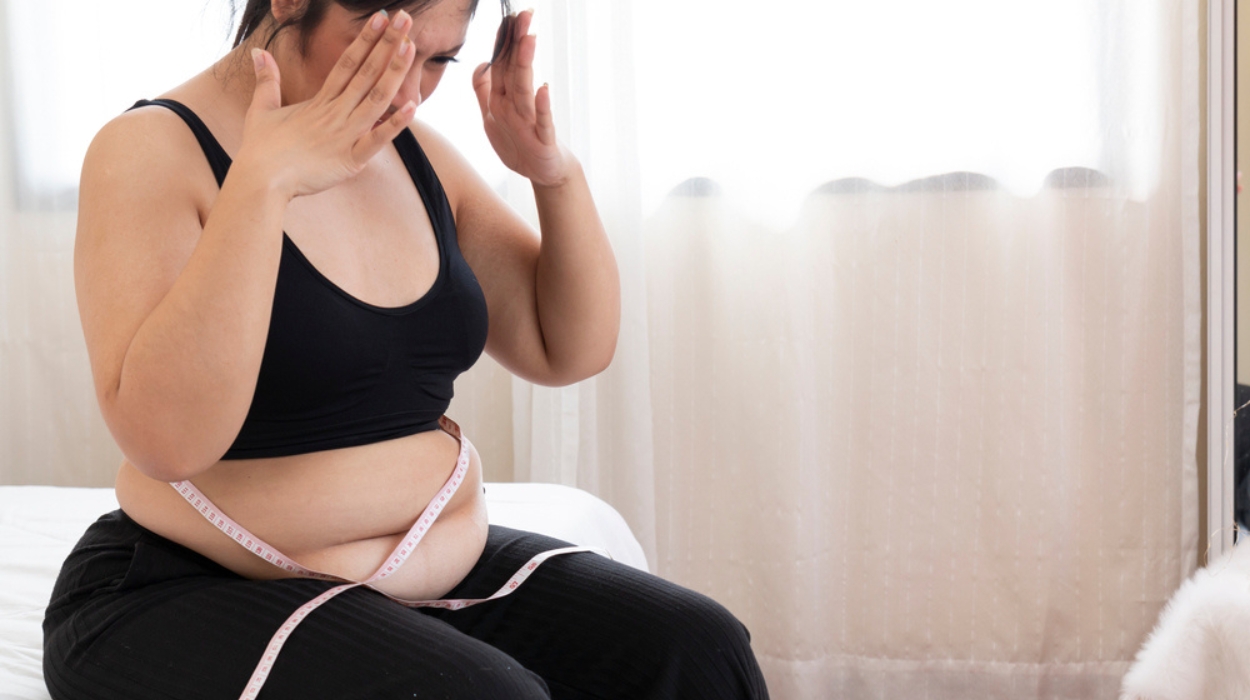How Much Fiber Per Day To Lose Weight: High-Fiber Foods To Lose Weight In 2024
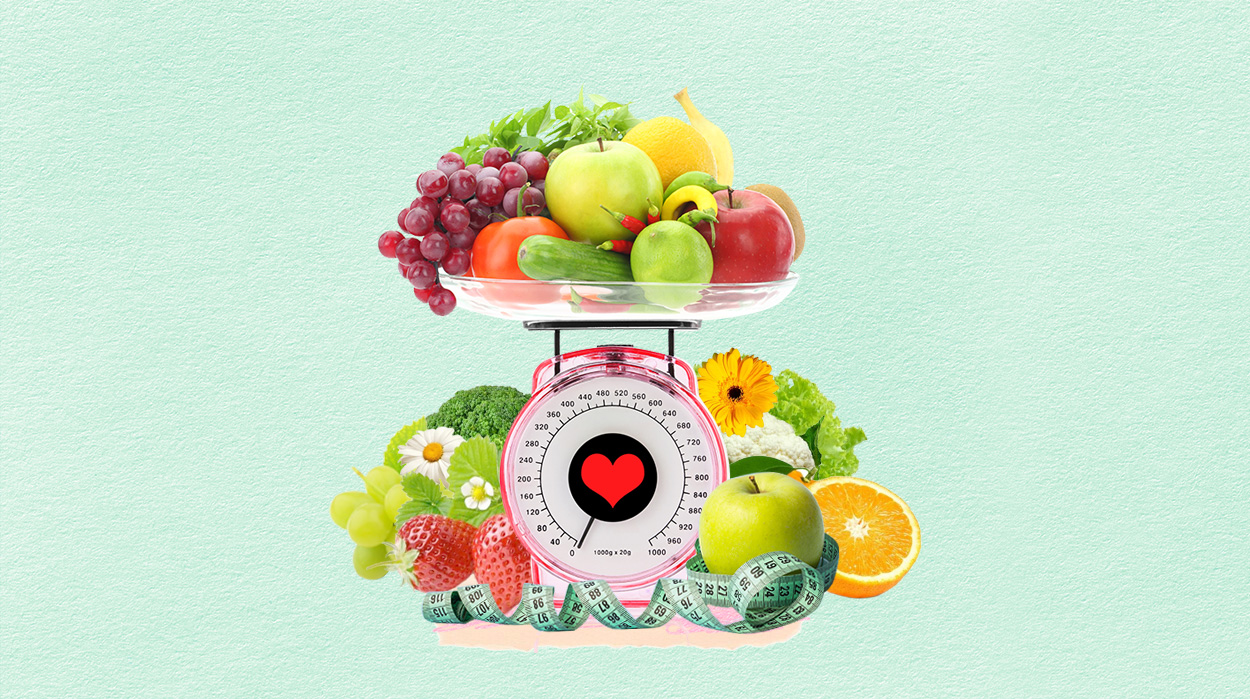
Consuming adequate dietary fiber is crucial to weight loss.[1] Fiber influences many body mechanisms and processes that can help you lose pounds and maintain a healthy body weight.
But how much fiber does one need to eat per day to lose weight? It varies slightly depending on age and gender. However, the Dietary Guidelines for Americans recommend 22-34 grams of fiber per day,[2] depending on the individual’s age and gender. This article will outline the health benefits of adequate dietary fiber, including weight loss, and explain the best ways to add fiber to your diet.
How Much Fiber Per Day To Lose Weight?
Adults should aim to eat a high-fiber diet, or approximately 22-34 grams of fiber every day, to assist in weight loss. Numerous studies have shown a direct correlation between high-fiber diets and weight loss. However, many Americans are falling short of the daily recommended amount of fiber.
How Much Fiber Per Day For Weight Loss?
Increasing your daily servings[3] of dietary fiber can lead to weight loss; how much you need to increase it depends on your baseline. Nutrition experts recommend a high-fiber diet for weight loss, but what classifies high-fiber?
If needed, use a calculator to help you establish how much fiber you currently eat and how much you need to increase per day to lose weight. Your gender and age will determine how many grams of fiber per day you’ll need to lose weight.
For example, the fiber needed for a woman to lose weight will vary from how much fiber a man needs per day to lose weight.
According to the latest Dietary Guidelines for Americans,[2] adult women should aim to consume 22-28 grams of fiber daily, while adult men should aim for 28-34 grams daily, depending on their age. The recommendations decrease as we age, but men still typically need more than women.
Consuming more fiber than recommended in the Dietary Reference Intakes can be considered a high-fiber diet. This may be a big shift for some, as many Americans are not getting enough fiber[4] in their daily diets.
Featured Partner Offer

PhenQ
- Helps to burn fat
- Crushes food cravings
- Boosts energy and balances mood
- High-quality formula
Money Back Guarantee and Free US Shipping
Does Fiber Help You Lose Weight?

Yes, adding fiber can help you lose weight. Fiber helps reduce weight through various channels.
Fiber positively influences the gut microbiome,[5] helping healthy bacteria thrive and creating a better gut-bacterial balance. Studies show that the more diverse the gut bacteria, the less the chance of developing visceral fat.[6]
Additionally, fiber helps the body produce short-chain fatty acids,[7] which support many protective functions. Short-chain fatty acids can decrease the risk of developing diabetes, improve insulin response, and inhibit weight gain by increasing satiety.
Fiber has even been linked to improved postpartum weight loss[8] within six months. This timeframe is similar to other types of weight loss when combined with increased physical activity and other dietary changes.
While working to increase fiber, some people may need additional support to help curb their appetite. If so, ask your doctor about taking an appetite suppressant or other weight loss supplements.
How To Increase Your Fiber Intake
Fiber can greatly influence our health, but because it can be so powerful, it should be increased slowly. Additionally, increasing water intake and fiber is important to prevent constipation.[9]
Try these tips[10] to increase fiber in your daily meals:
- Swap out processed flour products for whole grain products.
- Eat potatoes with the skin on.
- Add a serving of beans and vegetables to your meals.
- Have fruit for dessert.
- Snack on nuts and fruit instead of chips or candy bars.
High-Fiber Foods To Lose Weight
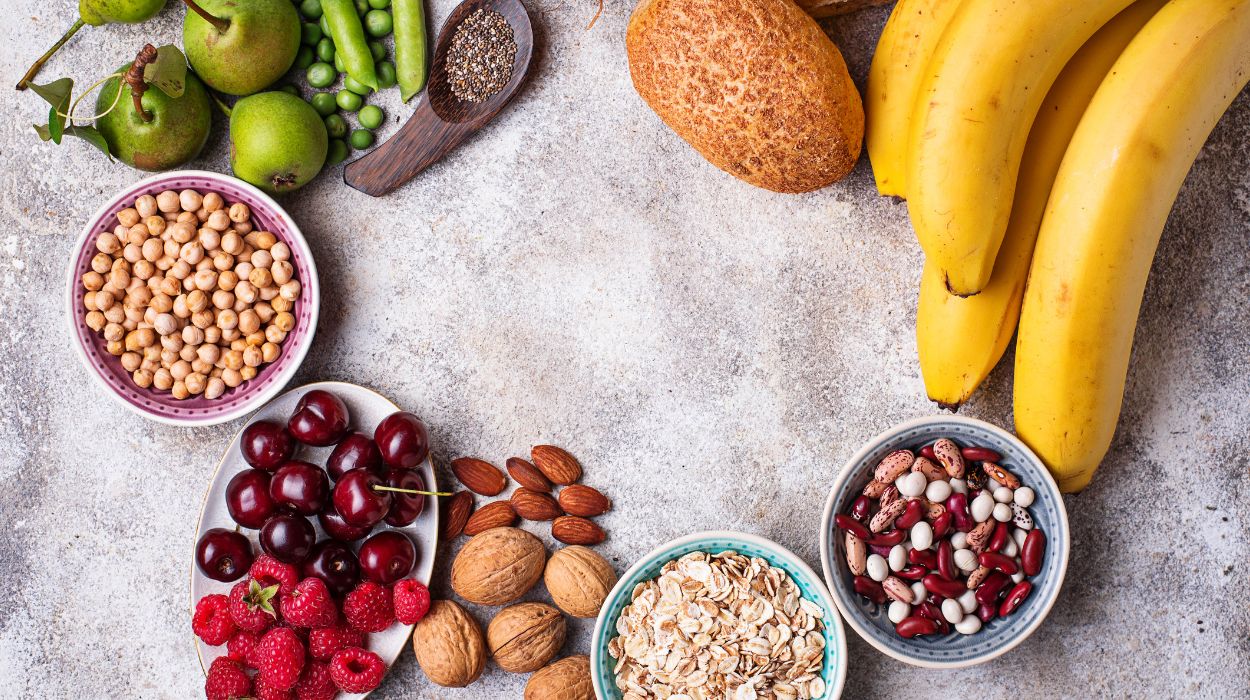
What counts as a high-fiber food? While there isn’t a universal definition for what constitutes a high-fiber food, some foods provide more fiber than others. For example, vegetables[11] tend to be high in fiber; they have between 2 grams and 9 grams of fiber per cup, depending on the vegetable.
Remember, the goal for adults is to have between 22 and 34 grams of fiber per day. This could look like having a cup of vegetables at every meal with half a cup of fruit for dessert.
While soluble and insoluble fibers benefit weight loss, the soluble fiber in foods like apples, bananas, beans, avocados, and peas can be especially helpful for weight loss. This is because soluble fiber dissolves in water, creating a satiating effect.
Review the following list of high-foods to lose weight:
- Vegetables: artichoke, green beans, kale, cucumber, celery, spinach, mushrooms, broccoli, cauliflower, zucchini, avocado, eggplant, peppers, pumpkin, Brussels sprouts, parsnip, corn, carrots, okra, collard greens, escarole, beets, cabbage, green peas, turnips, and rutabaga.
- Beans and legumes: navy beans, black beans, kidney beans, soybeans, chickpeas, black-eyed peas, pinto beans, lima beans, and lentils.
- Whole grains: oat bran, teff, bulgar, spelt, wheat bran, buckwheat, popcorn, whole wheat, brown rice, and barley.
- Nuts and seeds: almonds, walnuts, pistachios, pecans, cashews, pumpkin seeds, chia seeds, sunflower seeds, flax seeds, sesame seeds, chestnuts, coconuts, pine nuts, and hazelnuts.
- Starches: winter squash, white potatoes with the skin, and sweet potatoes.
- Fruits: Prioritize fruits that are low in sugar, such as fresh berries, apples, apricots, berries, kiwis, citrus fruits, cranberries, peaches, and plums.
Side Effects Of Too Much Fiber
Though fiber offers many health benefits, consuming too much too fast is possible. Side effects[12] of excess fiber include cramps, gas, bloating, diarrhea, and impaired mineral absorption. These symptoms are usually not severe and may reduce with time. It’s best to increase fiber intake slowly to allow your body a chance to adapt.
Featured Partner Offer
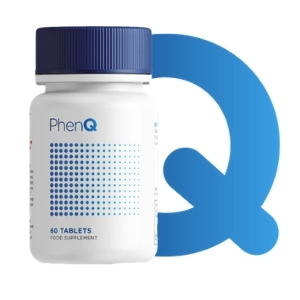
Other Weight Loss Support
Fiber is a critical influencer of weight loss; however, it’s not the only one. While increasing your fiber intake, don’t overlook other lifestyle habits, such as stress management, reduced alcohol consumption, and better sleep, that can help you lose weight.
Exercise is important to burn calories. Genetics, gender, and age will determine how many calories individuals need to burn to lose weight. This may be another good time to use a calculator or seek guidance from a registered dietitian.
You may find that a weight loss or fat burner supplement can give you an added boost in addition to dietary changes, exercise, and other healthy habits. Always consult a qualified medical provider before taking new medications or supplements.
Summary
Fiber is an essential nutrient to maintain health and assist in weight loss. Fiber can help stimulate weight loss through various mechanisms, such as increasing satiety hormones and promoting healthy gut bacteria. Still, experts have found that most Americans do not consume the recommended daily fiber amounts.
How much fiber one needs daily to lose weight will vary depending on age and gender. For example, a woman between the ages of 19 and 30 should consume 28 grams of fiber daily, while a man in the same age range should consume 34 grams daily. However, nutrition needs are very individualized. If you have questions about your fiber needs, consult with a registered dietitian nutritionist.
Frequently Asked Questions
Yes, it can. Consuming adequate fiber can help reduce body weight, resulting in overall fat loss. Additionally, fiber increases beneficial gut bacteria, correlated with less visceral fat.
All fiber is good for weight loss, but soluble fiber dissolves in water, increasing satiety and supporting weight loss.
Fiber supplements can have similar effects to the fiber found in whole foods. However, when you take fiber supplements, you miss out on other nutrients found in the foods, like vitamins, minerals, and antioxidants.
It can. Eating fiber causes the body to work harder because fiber does not break down easily during digestion. As the body tries to break it down, it expends energy and burns calories.
Read nutrition labels diligently to monitor the fiber content of food, and consider using a calculator to keep track of your daily fiber intake. A registered dietitian can also help you determine if you need to add more fiber to your diet.
Yes. Children 4-8 years old need 17-20 grams of fiber per day, depending on their gender. If they aren’t meeting recommendations, they can gradually add fiber to their diet until they reach this amount unless directed otherwise by their doctor.
Increasing fiber too quickly can cause unwanted side effects. If you are already eating a high-fiber diet, you would unlikely need additional fiber supplements unless your doctor advises differently.
Resources
- Miketinas, D., Bray, G.A., Beyl, R.A., Ryan, D.H., Sacks, F.M. and Champagne, C.M. (2019). Fiber Intake Predicts Weight Loss and Dietary Adherence in Adults Consuming Calorie-Restricted Diets: The POUNDS Lost (Preventing Overweight Using Novel Dietary Strategies) Study. Journal of Nutrition, [online] 149(10), pp.1742–1748. doi:https://doi.org/10.1093/jn/nxz117.
- USDA (2020). Dietary Guidelines for Americans 2020 -2025 . [online] Available at: https://www.dietaryguidelines.gov/sites/default/files/2020-12/Dietary_Guidelines_for_Americans_2020-2025.pdf.
- Zhang, L., Pagoto, S.L., Olendzki, B.C., Gioia Persuitte, Churchill, L.C., Oleski, J.L. and Ma, Y. (2018). A nonrestrictive, weight loss diet focused on fiber and lean protein increase. Nutrition, [online] 54, pp.12–18. doi:https://doi.org/10.1016/j.nut.2018.02.006.
- Quagliani, D. and Felt-Gunderson, P. (2016). Closing America’s Fiber Intake Gap. American Journal of Lifestyle Medicine, [online] 11(1), pp.80–85. doi:https://doi.org/10.1177/1559827615588079.
- Aoun, A., Darwish, F. and Hamod, N. (2020). The Influence of the Gut Microbiome on Obesity in Adults and the Role of Probiotics, Prebiotics, and Synbiotics for Weight Loss. Journal of Food Science and Nutrition, [online] 25(2), pp.113–123. doi:https://doi.org/10.3746/pnf.2020.25.2.113.
- Beaumont, M., Goodrich, J.K., Jackson, M.A., İdil Yet, Davenport, E., Vieira-Silva, S., Debelius, J.W., Pallister, T., Mangino, M., Raes, J., Knight, R., Clark, A.G., Ley, R.E., Spector, T.D. and Bell, J.T. (2016). Heritable components of the human fecal microbiome are associated with visceral fat. Genome Biology, [online] 17(1). doi:https://doi.org/10.1186/s13059-016-1052-7.
- Hjorth, M.F. and Astrup, A. (2020). The role of viscous fiber for weight loss: food for thought and gut bacteria. The American Journal of Clinical Nutrition, [online] 111(2), pp.242–243. doi:https://doi.org/10.1093/ajcn/nqz334.
- Alderete, T.L., Wild, L., Mierau, S.M., Bailey, M., Patterson, W.B., Berger, P.K., Jones, R.B., Plows, J.F. and Goran, M.I. (2020). Added sugar and sugar-sweetened beverages are associated with increased postpartum weight gain and soluble fiber intake is associated with postpartum weight loss in Hispanic women from Southern California. The American Journal of Clinical Nutrition, [online] 112(3), pp.519–526. doi:https://doi.org/10.1093/ajcn/nqaa156.
- Sadler (2022). Chronic Constipation in Adults. American family physician, [online] 106(3). Available at: https://pubmed.ncbi.nlm.nih.gov/36126011/#:~:text=First%2Dline%20treatment%20for%20primary,fiber%20supplementation%2C%20and%20osmotic%20laxatives.
- NHS Choices (2023). How to get more fibre into your diet. [online] Available at: https://www.nhs.uk/live-well/eat-well/digestive-health/how-to-get-more-fibre-into-your-diet/#:~:text=Tips%20to%20increase%20your%20fibre%20intake.
- www.dietaryguidelines.gov. (n.d.). Food Sources of Dietary Fiber | Dietary Guidelines for Americans. [online] Available at: https://www.dietaryguidelines.gov/resources/2020-2025-dietary-guidelines-online-materials/food-sources-select-nutrients/food-0.
- medlineplus.gov. (n.d.). Fiber: MedlinePlus Medical Encyclopedia. [online] Available at: https://medlineplus.gov/ency/article/002470.htm#:~:text=Side%20Effects.
More from Weight Management
-

How To Drink Apple Cider Vinegar For Weight Loss In 1 Week In 2024
January 10, 2024
Taking apple cider vinegar has become a sensation for its supposed health benefits, despite its sour taste. Apple cider vinegar may…Read more -
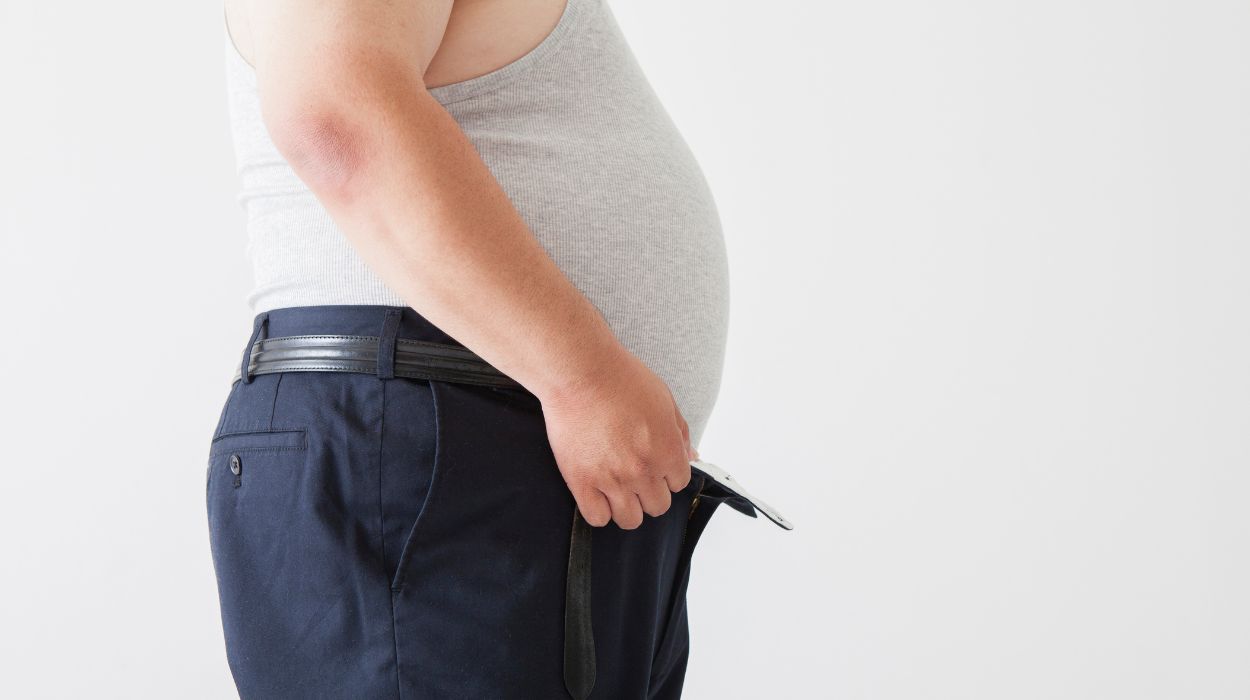
How To Lose Belly Fat After 50: Here’s 10 Tips For People Over 50 To Try In 2024
December 27, 2023
Losing weight over 50 can feel challenging, especially in stubborn areas like the abdomen. As we age, hormonal changes, slower metabolism,…Read more -

How To Lose Weight With Hypothyroidism – 10 Ways You Should Try In 2024
December 22, 2023
Hypothyroidism[1] is a condition that occurs when a person has low levels of thyroid hormone, and it most often develops when…Read more -

Hypnosis For Weight Loss: Unlocking Your Mind’s Potential For Success 2024
December 20, 2023
You’ve heard about various methods and tools to achieve weight loss and you might have looked into how to get ozempic.…Read more

